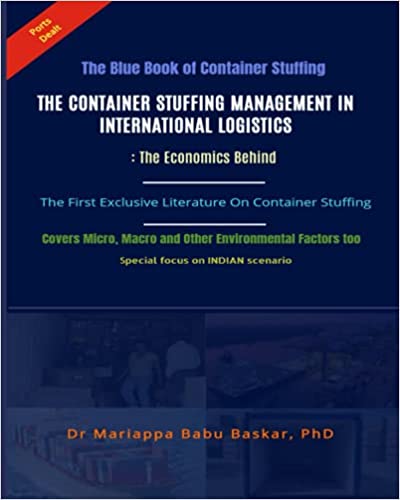
| 7. | Critical Evaluation of Container Stuffing | ||||
| 7.1 | Technical Literature Developmental Era of Container Stuffing | ||||
| 7.2 | Container Stuffing Problem Nature | ||||
| 7.2.1 | Decision & Optimization Problem | ||||
| 7.2.2 | Computational Complexity | ||||
| 7.2.2.1 | Polynomial Time (P) Algorithm | ||||
| 7.2.2.2 | Non-deterministic Polynomial Time (NP) Algorithm | ||||
| 7.2.2.2.1 | NP Hard Problem | ||||
| 7.2.2.2.2 | NP Complete Problem | ||||
| 7.3 | Container Stuffing Modellings | ||||
| 7.3.1 | Dimensions of an object | ||||
| 7.3.1.1 | 1 Dimensional or 1D Object | ||||
| 7.3.1.2 | 2 Dimensional or 2D Object | ||||
| 7.3.1.3 | 3 Dimensional or 3D Object | ||||
| 7.3.1.4 | 4 Dimensional or 4D Object | ||||
| 7.3.2 | Dimensional View of an Object | ||||
| 7.3.2.1 | 1 Dimensional or 1D View | ||||
| 7.3.2.2 | 2 Dimensional or 2D View | ||||
| 7.3.2.3 | 3 Dimensional or 3D View | ||||
| 7.3.2.4 | 4 Dimensional or 4D View | ||||
| 7.3.3 | Bin Modelling | ||||
| 7.3.3.1 | 1 Dimensional or 1D Bin Modelling | ||||
| 7.3.3.2 | 2 Dimensional or 2D Bin Modelling | ||||
| 7.3.3.3 | 3 Dimensional or 3D Bin Modelling | ||||
| 7.3.3.4 | 4 Dimensional or 4D Bin Modelling | ||||
| 7.4 | Types of Container Stuffing Algorithm / Approach | ||||
| 8.1.1 | Approximate Algorithm | ||||
| 8.1.2 | Exact Algorithm | ||||
| 7.5 | Forms of Container Stuffing Algorithm / Approach | ||||
| 7.5.1 | Online Algorithm | ||||
| 7.5.1.1 | Next Fit | ||||
| 7.5.1.2 | First Fit | ||||
| 7.5.1.3 | Best Fit | ||||
| 7.5.2 | Offline Algorithm | ||||
| 7.5.2.1 | First Fit Decreasing | ||||
| 7.6 | Container Stuffing Approaches | ||||
| 7.6.1 | Heuristic Algorithm | ||||
| 7.6.2 | Genetic Algorithm | ||||
| 7.6.3 | Stimulated Annealing | ||||
| 7.6.4 | Tabu Search Algorithm | ||||
| 7.6.5 | Linear Programming | ||||
| 7.6.6 | Local Search Algorithm | ||||
| 7.6.7 | AND/OR Graph | ||||
| 7.6.8 | Greedy Search Algorithm | ||||
| 7.6.9 | Asymptotic Performance Analysis | ||||
| 7.6.10 | Spatial Algorithm | ||||
| 7.7 | Container Stuffing Methods | ||||
| 7.7.a | Input Value Minimization (IVM) Method | ||||
| 7.7.b | Output Value Maximization (OVM) Method | ||||
| 7.8 | Container Stuffing Methodologies | ||||
| 7.8.1 | Cutting Stock Problem (CSP) | ||||
| 7.8.2 | Bin Packing Problem (BPP) | ||||
| 7.8.3 | Open Dimension Problem (OPD) | ||||
| 7.8.4 | Identical Item Packing Problem (IIPP) | ||||
| 7.8.5 | Object Placement Problem (OPP) | ||||
| 7.8.6 | Knapsack Problem (KP) | ||||
| 7.9 | Container Stuffing Patterns based on Consignment Configurations | ||||
| 7.9.1 | Homogenous Consignments | ||||
| 7.9.2 | Heterogeneous Consignments | ||||
| 7.9.2.1 | Strongly Heterogeneous Consignments | ||||
| 7.9.2.1.a | Robinson and George Test Data | ||||
| 7.9.2.2 | Weakly Heterogeneous Consignments | ||||
| 7.9.2.2.a | Loh and Nee Heterogeneous Test Data | ||||
| 7.9.2.2.b | Bischoff and Ratcliff Heterogeneous Test Data | ||||
| 7.10 | Container Stuffing Patterns based on Container Configurations | ||||
| 7.10.1 | Homogenous Containers | ||||
| 7.10.2 | Identical Containers | ||||
| 7.10.3 | Adjustable Containers | ||||
| 7.10.4 | Heterogeneous Consignments | ||||
| 7.10.5 | Strongly Heterogeneous Containers | ||||
| 7.10.6 | Weakly Heterogeneous Containers | ||||
| 7.11 | Container Stuffing Doctrines | ||||
| 7.11.1 | Authoritarian Doctrine | ||||
| 7.11.2 | Laissez-faire Doctrine | ||||
| 7.12 | Container Stuffing Ab Initio Ideologies | ||||
| 7.12.1 | Empty Container Ideology | ||||
| 7.12.2 | Prefilled Container Ideology | ||||
| 7.13 | Container Stuffing Types | ||||
| 7.13.1 | Stuffing Types in Input Value Minimization Methods | ||||
| 7.13.1.1 | Single Stock-Size Cutting Stock Problem (SSSCSP) | ||||
| 7.13.1.2 | Multiple Stock-Size Cutting Stock Problem (MSSCSP) | ||||
| 7.13.1.3 | Residual Cutting Stock Problem (RCSP) | ||||
| 7.13.1.4 | Single Bin-Size Bin Packing Problem (SBSBPP) | ||||
| 7.13.1.5 | Multiple Bin-Size Bin Packing Problem (MBSBPP) | ||||
| 7.13.1.6 | Residual Bin Packing Problem (RBPP) | ||||
| 7.13.1.7 | Open Dimension Problem (ODP) | ||||
| 7.13.2 | Stuffing Types in Output Value Maximization Method | ||||
| 7.13.2.1 | Identical Item Packing Problem (IIPP) | ||||
| 7.13.2.2 | Single Large Object Placement Problem (SLOPP) | ||||
| 7.13.2.3 | Multiple Identical Large Object Placement Problem (MILOPP) | ||||
| 7.13.2.4 | Multiple Heterogeneous Large Object Placement Problem (MHLOPP): | ||||
| 7.13.2.5 | Single Knapsack Problem (SKP) | ||||
| 7.13.2.6 | Multiple Identical Knapsack Problem (MIKP) | ||||
| 7.13.2.7 | Multiple Heterogeneous Knapsack Problem (MHKP) | ||||
| 7.14 | Present Container Stuffing System Vs Future Improved Container Stuffing System | ||||
| 7.14.1 | Uneconomic Working | ||||
| 7.14.2 | Extra Labour Cost | ||||
| 7.14.3 | Container Space Wastage | ||||
| 7.14.4 | Time Wastage | ||||
| 7.14.5 | Uneconomical Choice of Vessels | ||||
| 7.14.6 | Increased Transportation Charges | ||||
| 7.14.7 | Penalty Clauses | ||||
| 7.14.8 | Loss of Interest on Capital and Increased Interest Charges | ||||
| 7.14.9 | Exchange Rate and Inflation Losses | ||||
| 7.14.10 | Cancellation of Order and Loss of Goodwill | ||||
| 7.14.11 | Delay in C & F agent Commission | ||||
| 7.14.12 | Loss to the Importer | ||||
| 7.15 | Container Stuffing – Technical Area Vs Functional Area | ||||
